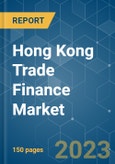Trade finance involves funding goods or services in a trade or transaction from a supplier to the final consumer, contributing to 3% of the annual global trade. It encompasses a variety of financial instruments that can benefit importers or exporters, such as finance for purchase orders, stock trading, and letters of credit. By providing the necessary capital for inventory and goods purchases, trade financing supports business growth and helps companies effectively manage their working capital. Utilizing trade finance can expand financing options based on trade cycles or release cash from existing inventory or receivables. Hong Kong is an excellent location for conducting business. It ranked fourth globally for business ease in the World Bank's Doing Business Report the previous year. Additionally, Hong Kong is recognized as the fifth most accessible economy out of 190 to start a business, with a quick, straightforward, and cost-effective process for business establishment.
Hong Kong is an important international financial center, boasting one of the most dynamic and liquid securities markets worldwide. The financial services industry is vital to Hong Kong's economy, contributing significantly to the city's GDP at 21.3%. Invest Hong Kong reports that 78 of the top 100 banks globally have chosen Hong Kong as their base. With 163 licensed banks and eight virtual banks, Hong Kong possesses a robust financial infrastructure. The city allows free movement of capital, with no restrictions on capital gains and tax on dividends. Additionally, Hong Kong holds the largest pool of CNY liquidity outside of Mainland China, making it an ideal gateway for foreign companies looking to enter the Chinese market and for Chinese firms expanding globally.
Hong Kong Trade Finance Market Trends
Technological Advancements and Digitalization are Driving the Market
The rapid improvement of technology and digitalization has led to substantial growth in the trade finance market in Hong Kong. Digital solutions, revolutionizing trade transactions, have replaced traditional paper-based processes. Blockchain technology revolutionizes supply chain finance and trade settlements by offering enhanced transparency and security. As a result, fraud and errors are significantly reduced. Moreover, using artificial intelligence (AI) and data analytics improves risk assessment, leading to more accurate credit decisions and bridging the financing gap for small and medium-sized enterprises (SMEs). Fintech startups in Hong Kong are introducing innovative digital platforms that simplify trade finance processes, making them more accessible and cost-effective. As businesses increasingly embrace these digital tools to optimize working capital and minimize expenses, the trade finance market is evolving to offer efficient solutions for the modern and interconnected global trade landscape.Banks Represent the Leading Market Segment
Banks offer a range of trade finance solutions, including letters of credit, trade credit insurance, and export financing. Thanks to their strong worldwide presence and extensive connections, they are the top choice for numerous companies engaged in global trade. In addition to providing financial support, banks offer expertise in navigating complex trade regulations and compliance issues, serving as trusted partners for buyers and sellers. Banks are critical in supporting secure and efficient global trade through their financial stability and trusted reputation.On the other hand, trade finance institutions specialize in trade finance solutions and cater to the specific needs of their clients. These non-bank financial entities, also known as trade finance houses, offer tailored services and flexibility, focusing on innovative solutions like supply chain finance and structured trade finance. They excel in providing customized services for various industries and trade scenarios.
Hong Kong Trade Finance Industry Overview
The trade finance market in Hong Kong is consolidated, with a few major players dominating the industry. These key players have a significant market share and influence in Hong Kong. Some of the major players in the market are the Bank of China, Standard Chartered, Bank of Communications, Hang Seng Bank, and HSBC.Additional Benefits:
- The market estimate (ME) sheet in Excel format
- 3 months of analyst support
This product will be delivered within 2 business days.
Table of Contents
Companies Mentioned (Partial List)
A selection of companies mentioned in this report includes, but is not limited to:
- Bank of China
- Standard Chartered
- Bank of Communications
- Hang Seng Bank
- HSBC
- DBS Hong Kong
- China Citic Bank International
- CMB Wing Lung Bank
- Shanghai Commercial Bank
- Public Bank*








